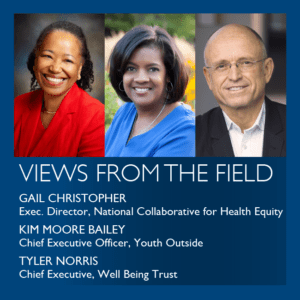
Gail Christopher, Executive Director, National Collaborative for Health Equity
Kim Moore Bailey, Chief Executive Officer, Youth Outside
Tyler Norris, Chief Executive, Well Being Trust
In recent weeks, we have seen people around the world turn to nature for reprieve and respite from the stress and uncertainty caused by the COVID-19 pandemic. Mounting research, combined with our personal and professional experience, suggest that improving equity in access to greenspace may help combat health inequities. Access to safe, nearby nature must be prioritized as critical public health infrastructure and not just an amenity for a few.
With each passing day of this crisis, it becomes clear that too many children and families lack equitable access to the benefits of nature at a time when they need it most. Just as systemic racism impacted the design and distribution of parks and greenspaces, African American and Latinx people in the U.S. are disproportionately dying from COVID-19 in yet another tangible reflection of the true cost of inequitable systems. As we think about how to help communities emerge from this crisis, will we repeat the mistakes of the past, or will we think holistically about what truly supports health and well-being? Let’s not make false binary choices between things like food, shelter, and transportation or access to education, jobs, health care, and nearby nature. People need all of these things to thrive.
There is substantive science behind what many intuitively understand: spending time in nature makes us feel better. Studies show that nature’s benefits are relatively greater for those who are negatively impacted by economic disadvantage, systemic racism, trauma, opportunity gaps, and other challenges. Three main factors emerge from the research on nature’s health benefits that are particularly relevant right now, especially in communities most impacted by systems of inequity: 1) a sense of calm, restoration, and a measurable reduction in stress, 2) enhanced mood, reduced anxiety and depression, and 3) improved resilience and ability to cope with adversity (Read more).
